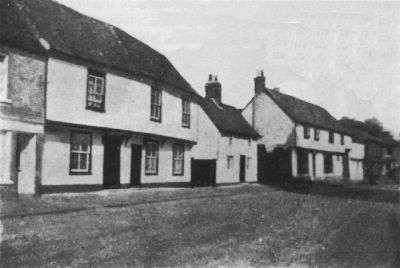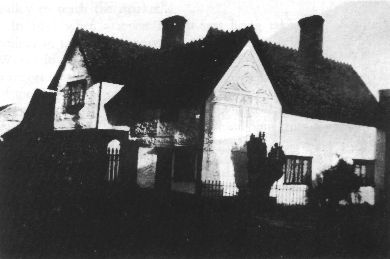The Medieval Town
Medieval Clare differed somewhat from the late town. Coming from Yeldham travellers crossed the Stour river by a small wooden bridge, and turned right into the Nethergate, passing a few dwellings such as the Stonehall. At the top of the street Mill Lane led do to a great stone-arched bridge which linked the castle and the Austin friary, and here a water mill was used for malt. It is probable that already in the fourteenth century the new river cut had been made to supply the corn-mill in the mill meadows. Continuing from the Nethergate across to the market the great gates, which were the main entrance to the castle, could be seen. The market itself was divided into two narrow streets by a row of houses, Market Street to the west and to the east Rotten or Ratton row. There was probably a market cross at the south end of the market, opposite the pillory and moothall and nearby was the wool hall (probably later the Bear and Crown Inn). At the north end of the market the road turned right towards Cavendish, skirting the castle bailey and crossing the Chilton stream by a bridge known as the Pysenebregge; and at the top of the hill beyond was a windmill. 
The Guildhall and Church Farm
The street east of the church was called Rotten Row. West of the church was the Heigh Row, with the guildhall opposite the church tower. Some of the medieval gilds can be traced, the gilds of St Mary, St Peter, Corpus Christi, and St John the Baptist, the last confined to Chilton men. All of these had religious and social trading functions. Their members, carrying their banners, took part in the church processions on the great Saint's Days. Behind the houses on the west side of the Heigh Row there was an embankment known as the Hawedych; from this ran a stream which crossed the road north of the church, and a narrow bridge had been built leading into Gosford Street, later Callis Street. On the west of this road extended the common lands of the manor. On the east was the picturesque St. Mary's House (now The Grove) with its five gables and jettied wing, originally the property of St Mary's Chantry. There were few other houses in the street; the vicarage was on the site of the present Old Vicarage. 
Fifteenth century pargetted house
About half a mile to the north, at the junction of the Chilton and Poslingford roads, stood the chapel of St Mary Magdalene. This is now a dwelling-house and has been very much altered, but traces of Norman architecture can still be seen. It was probably built as a wayside chapel, and it must have benefited when the annual fair was held at Wentford nearby. At the end of the Middle Ages one of its priests, Robert Wyncome, was described as helping the curate of the Town church and teaching in a grammar School in Clare. Two inns have an early origin. The Swan was used as an inn at the end of the fifteenth century, for in 1498 John Norfolk bequeathed to his son an alehouse called "le Swan", formerly known as "Quylters". (There is a reference to a tenement called Quilters in 1361). The Half Moon Inn is most probably of medieval origin for it was described, "le Moone Inne", as part of the lands of St Mary's Chantry in an inventory of 1549. In those days a stone house was a rarity, and the Stonehall is mentioned by name as early as 1309. Buildings were usually given timber or stone foundations, the walls composed of wattle and daub between timber uprights, with thatched or tiled roofs. There are still many houses of this kind in Clare, though the timbers are often plastered over. The picturesque priest's house, dated 1473, south-west of the church, is an excellent example of the early architecture, though its ornate pargetting is of seventeenth century origin, (recently renewed in part by local workmen). The interiors of many of the houses have massive timber work, often beautifully carved; and several houses, such as a bakers shop in the market, have ancient undercrofts with fine groined roofs of stone.
|



